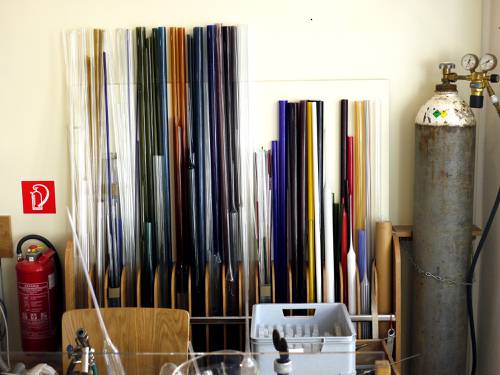
FAQ About The Role of Glassblowing in Art and Design

What is glassblowing?
Glassblowing is an ancient technique of shaping glass that involves inflating molten glass into a bubble using a blowpipe or tube. This skill allows artisans to create a variety of forms and structures, transforming the material's basic composition into artistic and functional pieces.

How does glassblowing impact modern art and design?
Glassblowing significantly impacts modern art and design by offering versatile medium that can be used in sculptures, architectural elements, and functional design pieces. Its transparency, ability to be tinted, and capability to be molded into intricate forms make it a valuable tool for artists and designers aiming for unique aesthetic outcomes.

What are the basic techniques used in glassblowing?
The basic techniques in glassblowing include gathering, marvering, blowing, swinging, and annealing. Each of these techniques aids in shaping the glass and controlling its thickness and design. Skilled glassblowers can manipulate these techniques to create both simple and detailed creations.

Where did glassblowing originate?
Historical records suggest that glassblowing originated in the regions around Syria, Mesopotamia, or Egypt around the first century BC. It rapidly spread across the Roman Empire, influencing numerous artistic and functional glass pieces known today.

How does glassblowing influence architectural design?
In architectural design, glassblowing contributes by providing customizable glass elements that can accentuate buildings. Techniques in glassblowing allow for the creation of bespoke windows, light fixtures, and decorative features which are integrated into architectural projects for both aesthetic appeal and functional purpose.

What materials are needed for glassblowing?
The primary materials needed for glassblowing include silica sand, soda ash, and lime. Additional materials might include various metal oxides and compounds to color the glass. Equipment such as a furnace, blowpipe, and annealing kiln are essential in the glassblowing process.

Who are some famous artists known for their work in glassblowing?
Renowned glassblowing artists include Dale Chihuly, known for his intricate and colorful glass sculptures; Lino Tagliapietra, celebrated for his mastery of traditional Venetian techniques; and Peter Layton, recognized for his contemporary glass designs. These artists have greatly influenced both the technique and artistic expression within the field.

What safety measures are important in glassblowing?
Safety measures in glassblowing are crucial and include wearing eye protection due to the bright glare from the furnace and hot glass, using heat-resistant gloves to manage heated materials, and ensuring proper ventilation to deal with fumes and vapors. Additionally, being aware of one's surroundings and using tools properly minimizes the risk of burns and injuries.

Can glassblowing be self-taught?
While some basics can be self-taught through instructional videos and books, glassblowing is intricate and often requires hands-on training under experienced glassblowers. Workshops and courses allow individuals to gain practical experience, making it easier to learn advanced techniques and safety protocols effectively.

What are the environmental impacts of glassblowing?
Glassblowing, like any manufacturing process, has environmental impacts, primarily relating to energy consumption from continuously running furnaces. However, many studios are now implementing more sustainable practices, such as using recycled glass called cullet, and adopting energy-efficient technologies to lessen their environmental footprint.

How has technology influenced modern glassblowing?
Technology has significantly influenced modern glassblowing by introducing advanced equipment that enhances precision and safety. Computer-controlled kilns, for instance, allow for more accurate temperature control, which helps prevent defects. Technology also aids in designing complex shapes through 3D modeling before the glassblowing process begins.

Is glassblowing considered a form of sculpture?
Yes, glassblowing is often considered a form of sculpture, as it involves shaping a versatile material into both artistic and functional forms. Many artists use glassblowing as a medium to create complex, sculptural works that are appreciated both for their aesthetics and craftsmanship.

What are some common challenges faced by glassblowers?
Common challenges faced by glassblowers include managing precise temperature control to avoid cracking, maintaining consistency in the glass shape throughout the blowing process, and mastering the various techniques to achieve complex designs. The medium's fluid nature and thermal properties require patience and skill to manipulate effectively.

Are there different styles of glassblowing?
Yes, there are different styles of glassblowing, including Venetian, Swedish, and contemporary styles. Venetian glassblowing is known for its detailed patterns and vibrant colors, while Swedish style emphasizes clean lines and minimalistic designs. Contemporary styles often blend these traditional methods with innovative techniques to create modern works.

How is color incorporated into glassblown objects?
Color is incorporated into glassblown objects using metal oxides and chemicals mixed into the glass batch or added to the surface during the blowing process. Techniques such as cane rolling and frit layering allow for different patterns and hues, providing a vast palette for artists to work with.

What is the significance of annealing in glassblowing?
Annealing is a critical process in glassblowing that involves slowly cooling the glass to relieve internal stresses. Proper annealing ensures that the glass does not crack or shatter once it returns to room temperature. This step is essential for stabilizing the object and preserving its integrity over time.

How is glassblowing used in modern product design?
In modern product design, glassblowing is used to create bespoke items such as light fixtures, vases, and kitchenware. The ability to form unique and aesthetically appealing shapes allows designers to offer customized and high-end products that stand out in the marketplace.

Can glassblowing be combined with other art forms?
Yes, glassblowing can be combined with other art forms such as painting, sculpture, and metalwork. Artists often use glass as a medium within mixed-media artworks, integrating it with other materials to enhance texture, depth, and visual interest in their pieces.

What role does glassblowing play in contemporary architecture?
In contemporary architecture, glassblowing plays a role in creating custom-designed elements that complement or enhance a building's aesthetic. From decorative facades to uniquely blown glass panels and lighting, glassblowing provides architects with the opportunity to incorporate both functional and artistic glass installations into their designs.

How can beginners start learning glassblowing?
Beginners can start learning glassblowing by enrolling in introductory classes or workshops offered by art schools and studios. These classes teach foundational techniques, safety procedures, and offer hands-on experience with equipment. Additionally, visiting glassblowing exhibitions and watching demonstrations can provide valuable insights and inspiration.
